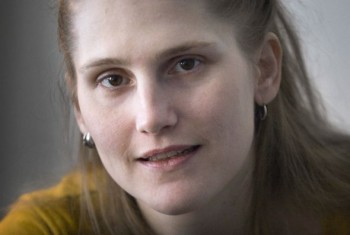The princess who quit
27 February 2014 | Authors, Interviews

Alexandra Salmela. Photo: Heini Lehväslaiho
Interview with Alexandra Salmela, whose second book, Kirahviäiti ja muita hölmöjä aikuisia (‘The giraffe mummy and other silly adults’, Teos, 2013), is for children – and for those adults who admit their silliness
Once upon a time there was a boy called Sulo. Just a normal lad, more a middle-of-the-road character than winner material. And not even always brave, let alone cheerful. An ordinary sprog isn’t enough for Sulo’s parents, so they take the boy to a child repair shop. There, new parts are fitted to children: virtuoso fingers, football-feet and angel-faces.
In addition to Sulo, Alexandra Salmela’s Kirahviäiti ja muita hölmöjä aikuisia (‘The giraffe mummy and other silly adults’) introduces us to the misunderstood Flabby Monster, Adalmiina, who wings through trees like an ape, and a father who absentmindedly loses his head. The work is the second book by Alexandra Salmela, who was born in Bratislava, in what was then Czechoslovakia, and now lives in Tampere.
A-L E: How did the idea of a story-book come up?
A.S.: Sort of by accident. At first I hadn’t thought of writing the stories in Finnish – after all, I didn’t spend my childhood in Finland, so the imagery was foreign to me. But I had written stories for a Slovakian magazine and when I mentioned that to my editor, he wanted to see what I had done. Then I translated something for the publishers and they liked it.
A-L E: The book was published simultaneously in Finland and Slovakia. Were the stories born at the same time in the two languages?
A S Yes, I wrote the book simultaneously in Finnish and Slovakian, sometimes literarily, so that I had Finnish and Slovakian files open at the same time on my computer. It’s hard to say which book is the translation…. Writing in two languages was like a multiple sieve, it taught me to spot mistakes and inaccuracies effectively.
A-L E: You have two children. Are they trial readers for your stories?
A S: No, that never really occurred to me. It turns out that I am much better at writing stories than telling them. When I tell stories I tend to get stuck on some detail or I begin to meander.
A-L E: The richly detailed, colourful illustrations are by Martina Matlovičová. Could you describe your illustrator a little?
A S: The world today is a very global place, and many illustrators use the same generic style, wherever they’re from. Martina is a find, she has her own distinctive style. The pictures in the Finnish edition of Kirahviäiti, by the way, are slightly paler than those in the Slovakian edition – and they’re still very colourful by Finnish standards.
A-L E: Four years ago you rose like a comet in the Finnish literary world with your first novel, 27 eli kuolema tekee taiteilijan (‘27 or death makes the artist’). It was interesting, among other things, for the fact that you wrote in Finnish, even though Finnish is not your native language. The novel received the Helsingin Sanomat Prize for the best debut novel and was also on the shortlist for the Finlandia Prize. What do you think of the media circus that surrounded it now?
A S: Everything happened very quickly and at once. Suddenly there was too much attention, for me as well as, I’m sure, for the reading public. The media attention may actually have harmed the book. The hoo-ha ended as quickly as it had begun, and afterwards there was a long, long silence. The manuscript of my new novel has been stalled for a long time – but I have begun to find the right form.
A-L E: There’s a lot of absurd humour and dizzying twists of the plot in the stories of Kirahviäiti. But beneath the wildness there’s often a serious tone and themes – for example an ecological message and acceptance of difference.
A S: Certainly. I wanted to write a book that would be as readable and rewarding for adults as it is for children. But I tried to conceal deep and serious subjects in the stories in such a way that they wouldn’t seem too humourless or ranting. This balancing act sometimes caused headaches in the writing. It felt as if I was just pursuing my own agenda – the texts were too heavy, boring for children, ranting. A that point I just had to let imagination take control: the wilder and more absurd the story, the better and more digestible it became, the excess weight was dumped on the sharp bends. 1800 characters per story was my aim, and I didn’t exceed it by very much.
The short form is best, in my opinion – children can’t be bothered to read a couple of pages of description of the door that leads to Sleeping Beauty’s castle. My stories also begin and end abruptly: they invite the reader to imagine what happened before the start and what might happen after the end of the story.
Translated by Hildi Hawkins
Tags: children's books, illustration
No comments for this entry yet
Leave a comment
-
Explore more…
Also by Anna-Leena Ekroos
The party's not yet over - 14 November 2013
Journeys to nearby places - 18 April 2013
Movies and mores - 16 April 2012
Fools and devils - 30 June 2007
-
About the writer
Anna-Leena Ekroos (born 1968) is a freelance journalist and critic living in Vaasa.
© Writers and translators. Anyone wishing to make use of material published on this website should apply to the Editors.
